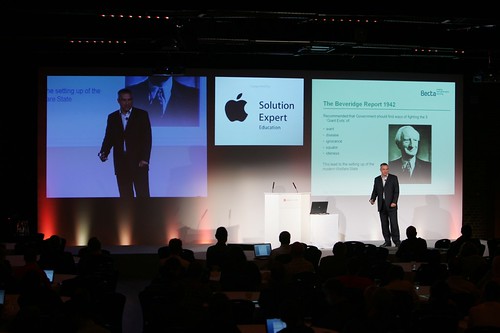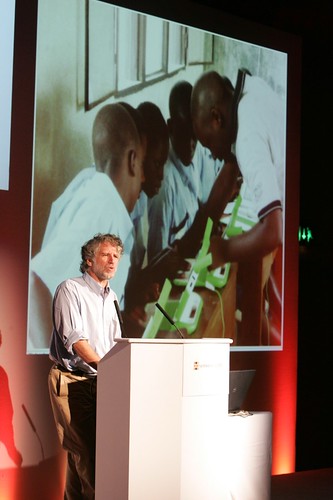Digital Inclusion and Mobile Learning
Following reviews from others working in accessibility, inclusion and Higher Education, I’ve been watching footage from the recent Handheld Learning Conference in London. Extensive online proceedings including video are available on the conference website and via iTunes.
I’ve supplied links to videos alongside notes on the first 5 presentations from the Inclusion Session below. Notes from Sal Cooke’s presentation are most complete due to the range of sources she draws on and my own interest in the projects she cites. For brevity, this a descriptive account, not an analytic one. As I did not attend the conference myself, comments are very welcome. Please note all links open in a new window and many presentations feature slides that are not audio-described.
Inclusion Session Introduction: Donald Clark (video, predominately audio) 8 mins.
I recommend a listen to Clark’s introduction, which he also outlines in his blog article ‘Handheld Learning: Malcolm Maclaren et al.’ Clark poses provocative questions to delegates:
- To what problem is ‘inclusion’ an answer? Doesn’t everyone have a mobile?
- Is ‘Digital Divide’ an outmoded term? It’s no longer a poor/rich divide, but a series of fractures.
Specifically, here Clark identifies a disjuncture in the UK between ‘analogue’ educational practices in schools and the ‘digital’ world that characterises nearly everything else.
- Can inclusion actually result in exclusion? The fact that the few don’t have the technology means the many don’t get anything.
In terms of accessibility discourse, I feel this relates to the observations made by Brian Kelly and others regarding the development of Adaptable and Accessible practices. Video and other media from Brian’s presentation at TechShare are available via his blog.
- Has the ‘Digital Britain’ report helped or hindered our digital future? It’s largely about TV, Radio and Newspapers or punishing file-sharers.
Clark also questions policy approaches, making a strong critique of Digital Britain, identifying how a scoping document has become a punitive exercise.
Speaker 1: Niel McLean: ‘Inclusion: The Home Access Story’ (video) 20 minute talk and 5 minutes of questions. Note: This presentation opens with brief use of Russian in an illustrative point at the start of the talk.

Niel McLean is Executive Director of Becta (the British Education and Communications Technology Agency), here he introduces the Home Access project which seeks to ensure that all pupils in state education in England have the opportunity access to computers and internet connectivity for education at home. The programme supplies funding to achieve this. Aside from McLean’s discussion of socio-economic deprivation as a distinct category within the inclusion agenda, this talk includes a valuable dissection of the political grounds for Government’s role in ensuring home-based access to education.
Speaker 2: David Cavallo on One Laptop Per Child (video) 35 minutes.

David Cavello is the Chief Learning Architect at MIT on the One Laptop Per Child project. One Laptop Per Child is a renowned project that aims to create educational opportunities for the world’s poorest children by providing each child with a rugged, low-cost, low-power, connected laptop with content and software designed for learning. Cavallo is a charismatic speaker and news on the progress of the project is always engaging (as is Dr Sugata Mitra’s Hole in the Wall project in India). Questions and answers relate to bandwidth, collaboration and infrastructure.
Speaker 3: Elizabeth Hayes ‘What can we learn from The Sims about inclusive Game Based learning?’ (video) 25 minutes.
Hayes’ focuses on gender and games based learning, reporting the educational implications bourne out of non-traditional gamers (middle-aged women) approaches to game design and ‘modding’ The Sims.
Speaker 4: Sal Cooke from JISC TechDis (video) 24 minutes
Cooke’s presentation focuses on mobile device research and relations to inclusion, disability and Special Educational Needs in a wide-ranging talk that draws on multiple projects and resources. She begins by reporting recent ministerial announcements about mobile devices in Education. These include: Funding for 118 projects, 30 significant case studies with 8 to be studied in-depth to examine impact. Projects will particularly focus on:
- Field Work, Special Needs, home access, staff and learner capacity
- Innovation in the curriculum
- Motivation of the learner, particularly the disengaged
- Measures of significant improvements in learning outcomes
However, she quickly moves on to point out that much of this research has arguably already happened. Specifically, the ‘Portables in Action’ NCET Project reported outcomes in 1994 and concluded at that time that:
“Educational achievements are enhanced by pupils using portable computers, including the volume and quality of their work, particularly in accuracy and standard of presentation”
“there is clearly a great potential for using portable with special educational needs pupils”
So are the issues the same, or have they changed? Cooke covers several key areas for contemporary deployment of mobile devices and digital content. Specifically she cites issues with assessment and the process of assessment for those who require additional time and assistive technologies. How will these learners’ needs be met?
Next Cooke congratulates MoLeNET, the Mobile Learning Network (a collaborative project between the Learning and Skills Network and partner Further Education institutions in the UK) with reference to the powerful resources that MoLeNET has provide for inclusive approaches. A slide states its’ mission to:
- Make learning more convenient, accessible, inclusive and sensitive to learners; individual needs and circumstances
- Encourage non-traditional learners and learners who have not succeeded in traditional learning to engage in learning and to improve in confidence and self-esteem
- Help teachers to provide different learning activities to suit different learning styles or preferences and different ability levels.
Cooke stresses the need for this approach to be transferred into other educational sectors. She also refers to findings from MoLeNET research to refute common myths that mobile technologies might ‘somehow be inappropriate or too difficult for learners with learning difficulties and/or disabilities‘ or that ‘allowing the use of mobile technologies, particularly mobile phones, in schools and colleges would make it difficult for teachers to control classes and would encourage inappropriate behaviour‘. To support this, Cooke cites evidence and best-practice case studies available via MoLeNET and describes how mobile devices can assist in a multitude of different situations. She also lists the publication GoMobile as a source highlighting many innovative uses of handheld devices.
Next Cooke illustrates how technologies have moved into the home and represent an untapped learning resource that arguably represents the crux of the Inclusion agenda. One slide depicts a toy pen from ToysRUs that helps children learn to read. Cooke observes that this is the same technology that was being given to dyslexic students as an assistive technology only a couple of years ago. She indicates how assistive technologies are now cheap, mainstream and in the home and broadly conceived as ‘gadgets’.
Cooke links to further evidence from the ongoing ‘Me and My Mobile Phone’ survey by Ian Milliken at Iansyst, the University of Southampton and JISC TechDis, listing highlights from learners with additional access needs. A graph (difficult to see on video) shows that screen size and text size, though significant, are a not considered an overwhelming problem by users with access needs because there are other things that they do with a phone. She quotes one participant:
“…more mobile phone companies should be aware of the software available to help those who are sensory impaired and either offer to put the software on, suggest where to get the software or make sure…their phones are compatible with the latest software”
This research also shows that the vast majority of participants do not want to speak into their device to navigate content, but they do want to hear it.
Cooke concludes with thanks to industry for the huge leaps made in mainstreaming accessible platforms and apps. Apps that could not have previously come to market are now available and ready to use, breaking barriers that were insurmountable in the past . She cites several strong examples including:
- Yahoo collaboration with Reading University to provide automatically captioned video
- Rix Centre (University of East London) work on symbol card recognition, enabling users to surf the web and listen to emails using only symbols.
- The addition of Radio Frequency Identification (RFID) to new phones in 2010. RFID has been used by the RNIB for years. With international roll-out immanent, educational applications of RFID are being developed.
Cooke goes on to refer to ‘Independent Specialist Colleges: Specialists in Innovation citing the innovative work undertaken within Special Education. She asks how this wealth of knowledge can be married to mainstream practice to for mutual benefits in national programmes. How can we make a real difference? How do we equip staff with the necessary skills? Will mobile learning require new kinds of teaching?
Here Cook returns to the push of new technologies that are changing inclusion work, using the example of RoboBraille, winner of the European Access-IT award.
Cooke states the institutional focus must be on Continuing Professional Development. What do people do with technologies in their roles? Do people create mobile resources? Do they apply different teaching techniques? Or do they use mobile devices predominantly for collaboration and communication? How many people know what is in their Single Equality Duty Scheme about Mobile learning? How do we upskill this workforce?
Cooke closes the presentation re-asserting print impairment as a major access issue. Under this topic she refers to contemporary developments in e-books and e-publishing within Education. Finally, in response to previous presenters, Cooke asserts Digital Inclusion a matter of rights, not politics. For some people it is life. She quotes a learner in a specialist school to underline this fact: ‘I cannot speak but I use my phone all the time, because I want my mum to be able to see me and see how I am’.
6 comments